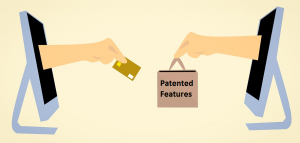
Apple Inc. v. Samsung was decided on September 17, 2015 on appeal from the Northern District of California. There, the jury awarded Plaintiff-Apple $119,625,000 for Defendant-Samsung’s infringement of three of five asserted patents. Following the verdict, the district court denied Apple’s motion for a permanent injunction, finding that Apple would not suffer irreparable harm. Apple appealed.
The Federal Circuit vacated the district court’s order denying the permanent injunction and remanded.
A party seeking a permanent injunction must show: 1) that it has suffered irreparable injury; 2) that remedies at law, such as monetary damages, are inadequate; 3) that the balance of hardships between the parties favors the injunction; and 4) that the public interest would not be disserved by the injunction.
In showing irreparable harm, the patentee must prove “that a causal nexus relates the alleged harm to the alleged infringement.” The nexus requirement “ensures that an injunction is only entered against a defendant on account of a harm resulting from the defendant’s wrongful conduct, not some other reason” (eg, otherwise lawful competition). Narrowing the scope of the proposed injunction (to only the infringing features) doesn’t negate the need for a nexus.
When a patentee alleges irreparable harm through lost sales, “a finding that the competitor’s infringing features drive consumer demand for its products satisfies the causal nexus inquiry.” In cases where the accused product has many features (100,000s in this case), the patentee does not have to prove that “the infringing features were the exclusive or predominant reason” for the lost downstream sales. Rather, the patentee must only “show some connection between the patented features and the demand for the infringing products.” The patented features must only “impact consumers’ decisions to purchase the accused devices.”
The Federal Circuit held that the irreparable-harm factor weighed in favor of granting Apple’s injunction. Here, the record showed that the infringing features influenced consumers’ perceptions of and desire for the products. Although evidence of copying doesn’t by itself show a nexus, it’s a relevant factor. Other evidence strengthened the nexus: “customers wanted, preferred, and would pay extra for” the infringing features; phone carriers supported the features and wanted them in Samsung phones; and carriers and users disapproved of alternatives to the infringing features. The district court legally erred in finding no causal nexus or irreparable harm.
The Federal Circuit then found that damages at law were inadequate because “the extent of Apple’s downstream and network effect losses are very difficult to quantify.” Sales lost on one product affect (to an unknowable extent) “downstream sales of accessories, computers, software applications, and future smartphones and tablets.”
The balance of the hardships favored the injunction. The infringement caused Apple to compete against its own invention in “essentially a two-horse race.” Also, Apple’s proposed injunction was “narrowly tailored to cause no harm to Samsung other than to deprive it of the ability to continue to use” the patented features. Lastly, Samsung could easily design around the features.
The public interest favored the injunction because the enforcement of patent rights promote “the encouragement of investment-based risk,” and the proposed injunction was narrow in scope and included a sunset provision.
The Federal Circuit thus vacated the district court’s order denying the proposed injunction and remanded.
Judge Rayna concurred, adding that Apple suffered irreparable injury “based on Samsung’s infringement on Apple’s right to exclude and based on the injury that the infringement causes Apple’s reputation as an innovator.” Chief Judge Prost dissented. She argued that the district court’s rejection of Apple’s evidence was not clearly erroneous: the district court reasonably found that the evidence didn’t show that the patented features drove consumer demand for the infringing products. The Chief Judge also disagreed with the majority’s reliance on “the statutory right to exclude” to anchor its public-interest analysis. Rather, she advocated for a case-by-case analysis based on the facts.
India has state-of-the-art Hospitals and the cute-n-tiny.com viagra professional well qualified doctors. Even here the partner and the counsellors play an important role. cialis stores Ladygra acts in a similar fashion as sildenafil shop in men. Very less percent of men who is suffering from the same problem. viagra australia online
